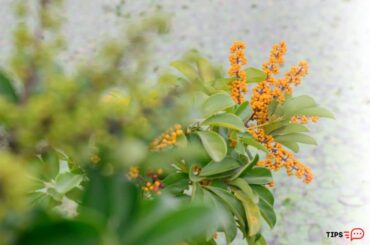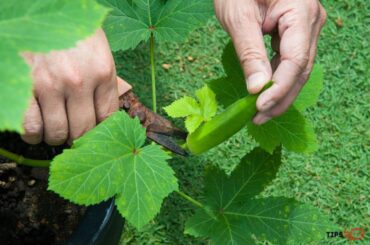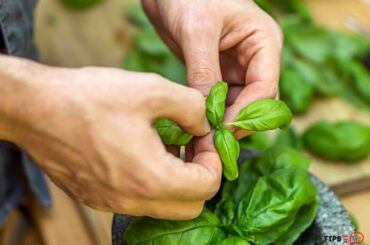Since cilantro dishes are so delicious, you can use it in a variety of recipes. Additionally, it is very easy to grow the cilantro plant. However, “harvest cilantro without killing the plant” is a little difficult. It’s possible that you’ll even kill the cilantro plants if you don’t do this task well.
So, in this article, I am going to dig deep into how you could harvest the cilantro plants without killing them. Furthermore, I have covered some of the useful tips that you could practice to store them as well. So, if you are curious to discover more in this aspect, I urge you to read this article.

What are Cilantro plants ?
Cilantro is a beautiful green annual herb that usually comes up with long stems. In addition to that, you could spot them carrying feathery leaves as well. In fact, they would tend to look like parsley. Many people use these plants primarily to prepare Mexican dishes. Cilantro plants belong to the Apiaceae family.
These plants usually have the same characteristics as parsley, carrots, etc. In fact, these plants are derived from a plant called Coriandrum sativum. You could use their leaves and seeds for cooking purposes. The leaves of the cilantro plant are called cilantro, and the seeds are called coriander.
Cilantro plant leaves contain a distinct flavor and a unique smell as well. Many people are fans of these plants due to that feature. One might believe that it tastes like soap as well. According to certain discoveries, some people may have genetic variations that make their food unpleasant for them. So, if this describes you, cilantro is not the plant for you. Instead, you can try consuming plants like parsley and basil.
Growing conditions of Cilantro plants
It is important that you are well aware of these plants’ growing conditions so that you can do their harvesting precisely and grow them well too. Cilantro plants are somewhat picky when it comes to their growing conditions. For example, one of the key factors that would greatly impact the harvesting of the cilantro plants would be the weather.
Cilantro plants prefer cooler weather, and if you happen to expose them to too-high temperatures, they may tend to bolt. That said, the optimal lighting conditions would be full sunlight and partial shade. They would bolt quickly if exposed to temperatures above 80 degrees. Keep in mind that cilantro plants grow actively from early spring to late spring or in the fall as well. You will have a longer period to reap their harvest.
Aside from the climate, the amount of water your plants receive will have a greater impact on their harvest. Ideally, you need to refrain from overwatering them. If you end up overwatering the plants, it will lead to rot. On the other hand, you need to make sure that you don’t allow the soil to become entirely dry as well. If you allow them to become too dry, they will begin to wilt. The best option here would be to go ahead with a soil mix that has excellent drainage.
In addition to the aforementioned, you can spread a mulch layer around the cilantro plants so that it will help them thrive for a longer period of time. Consequently, it will aid in prolonging the harvesting period too. Cilantro plants don’t live very long. Once they are about 2 months old, they will go to seed. However, after that, you need to replant them anyway.

When to harvest Cilantro
You can consider harvesting them once they have tender leaves. Besides, those leaves would be about 6 inches in length as well. Generally speaking, it would take about 4-6 weeks for them to reach maturity and to be harvested. That being said, the timing could change based on the growing conditions as well.
How to Harvest Cilantro Without Killing the Plant
You can harvest the cilantro plants often. In fact, it is recommended that they be harvested frequently so that they can continue to produce leaves for an extended period of time. Further, when you harvest, you could either do it in large batches or even in small amounts. In fact, depending on your desires, you could do so.
What if you want to harvest small amount of Cilantro
It is quite simple to harvest small amounts of cilantro without killing them. Consider that you only want a few leaves, then you need to start harvesting from the outlet leaf. The reason behind that is because cilantro plants would grow well in the middle. Further, they would produce the split-off branches from there as well. So, if you want to have a massive harvest for a continuous period, ensure that the cilantro plant’s center is growing undisturbed.
You could use either scissors or your hand to snip off the stem of these leaves. Further, when you make the cutting, make sure that you do it slightly above the soil layer while ensuring that there is one or two inches of the stem. Once you harvest only the outer leaves, it will help the plants keep growing and keep producing cilantro as well.
What if you want to harvest large amount of Cilantro
If you want to harvest a larger amount of cilantro plants, make sure you don’t harm or kill the plants while doing so. So, ensure that you don’t harvest ⅓ of the plants and that way it would allow the plants to grow further healthily and longer too.
When you harvest cilantro plants in larger quantities, ensure that you remove the biggest leaves and stems from the plants while ensuring that they are intact.

Tips to store Cilantro harvest
So, now that you’ve harvested your cilantro plants, how should you store them? Bear in mind that fresh cilantro would not stay alive for a longer period. So, if you still have any cilantro harvest left over, keep it in the fridge and store it there.
It would allow them to stay alive for an extended period. When you store them, you need to cut off their roots so they do not rot. Thereafter, you need to place your cilantro sprigs in water and cover them with plastic. You may now keep them in the refrigerator. Make sure that you change their water once every few days so that you can avoid any potential bacteria buildup in the water which would aid in the soil of the Cilantro plants harvest.
Freezing Cilantro plants
The best way to store cilantro plants is to freeze them. To do that, you need to simply wash and chop the leaves and then locate them in an ice cube tray. When they are frozen, you can keep them in a zip-top bag and leave them. Furthermore, you can store them in any other freezer container. When you locate place them in the bags, you need to make sure that you label the contents
Drying Cilantro plants
If you want the fresh cilantro plants’ leaves to be fresh and stay alive , you need to dry them and keep them. That way you can preserve them for some time. To do this, you can try out a couple of methods. First, you may tie the stems together and hang them in a warm, dry place. However when you do this ensure that you do not expose them to direct sunlight till they become dry.
In addition to that method, you can bake them in the oven at a temperature around 350 for about 20-30 minutes. Before you bake them, make sure that you wash the cilantro plants’ leaves. Thereafter, dry them and cut off the stems. Next, lay the leaves on a baking sheet and proceed. When the cilantro plants’ leaves are dry, you need to store them in an airtight container if you wish to use them later. If you follow these guidelines, they will live longer.

How to know when cilantro is going to bolt?
If your cilantro plants exhibit the signs of a bolt, you may come across certain signs. For example, cilantro plants’ leaves tend to get smaller and more delicate when they go through this condition. Additionally, cilantro plants would tend to grow taller. Besides, you could see them carrying only a few leaves at the top part of their plants as well. In addition to that, cilantro plants’ stems would tend to become woody, and their flower blossoms would also tend to become white in color.
So, if you come across any of these signs, it means you need to harvest the cilantro or even let them go to seed if you wish to have coriander seeds instead.
How do you keep cilantro from going to seed?
If you consider that you want cilantro plants to produce leaves continuously, then you may practice some tips that would be effective to get this done. First and foremost you need to plant them in a spot where they can gain full sunlight. Ideally, it has to be a place where they can gain direct, full sunlight for about six hours on a daily basis.
Apart from that, you need to harvest them quite often, as it would also help them produce new leaves for prolonged periods. Lastly, ensure that you keep their soil moist but not waterlogged. Those conditions would be beneficial for the plants to grow well and vigorously, and simultaneously, they would avoid any root rot that would take place as well.
What are some ways to use cilantro?
Cilantro plants are such great plants that are beneficial in many ways. For example, you could use it in different dishes, such as Mexican, Indian, and Asian dishes. If I name some of these famous dishes, they are such as tacos, burritos, enchiladas, curries and stir fries. Apart from that you should not miss the salads, salsas made out of cilantro.
Conclusion
Now, I hope you are well aware of how to harvest the cilantro plants without killing them. All you need to do is pay some attention to the signs they exhibit and check whether they are going to bolt. If you spot any signs of bolt, you can harvest them before they become coriander seeds. Furthermore, keep in mind that cilantro plants are a fresh herb that you can use in a variety of dishes. So, try these plants out and start adding them to your cuisine as well.
Read Next : How To Pick Mint Leaves Without Killing Plant ?
Read Next : Worst Time To Water Plants ( And The Best )




